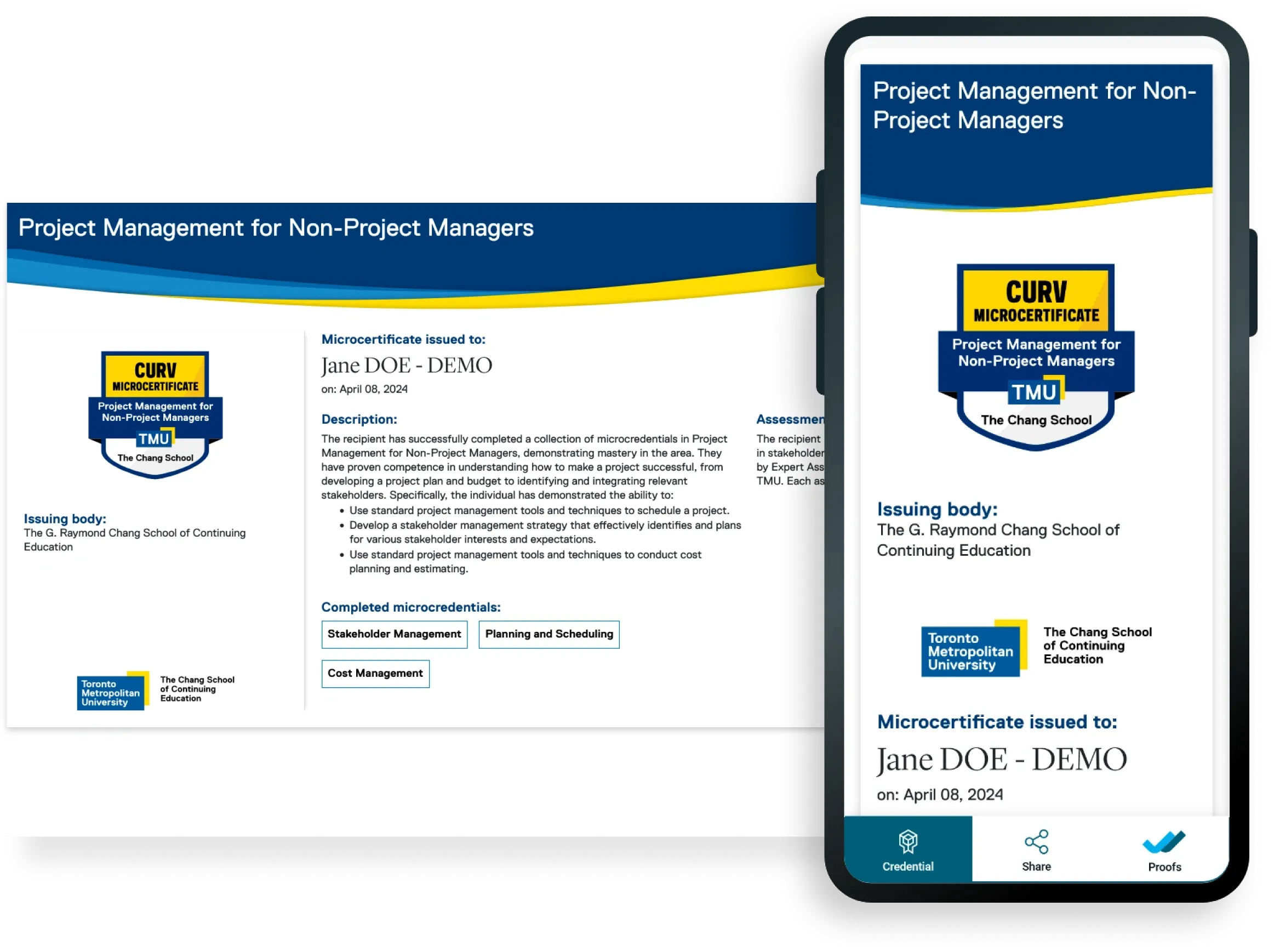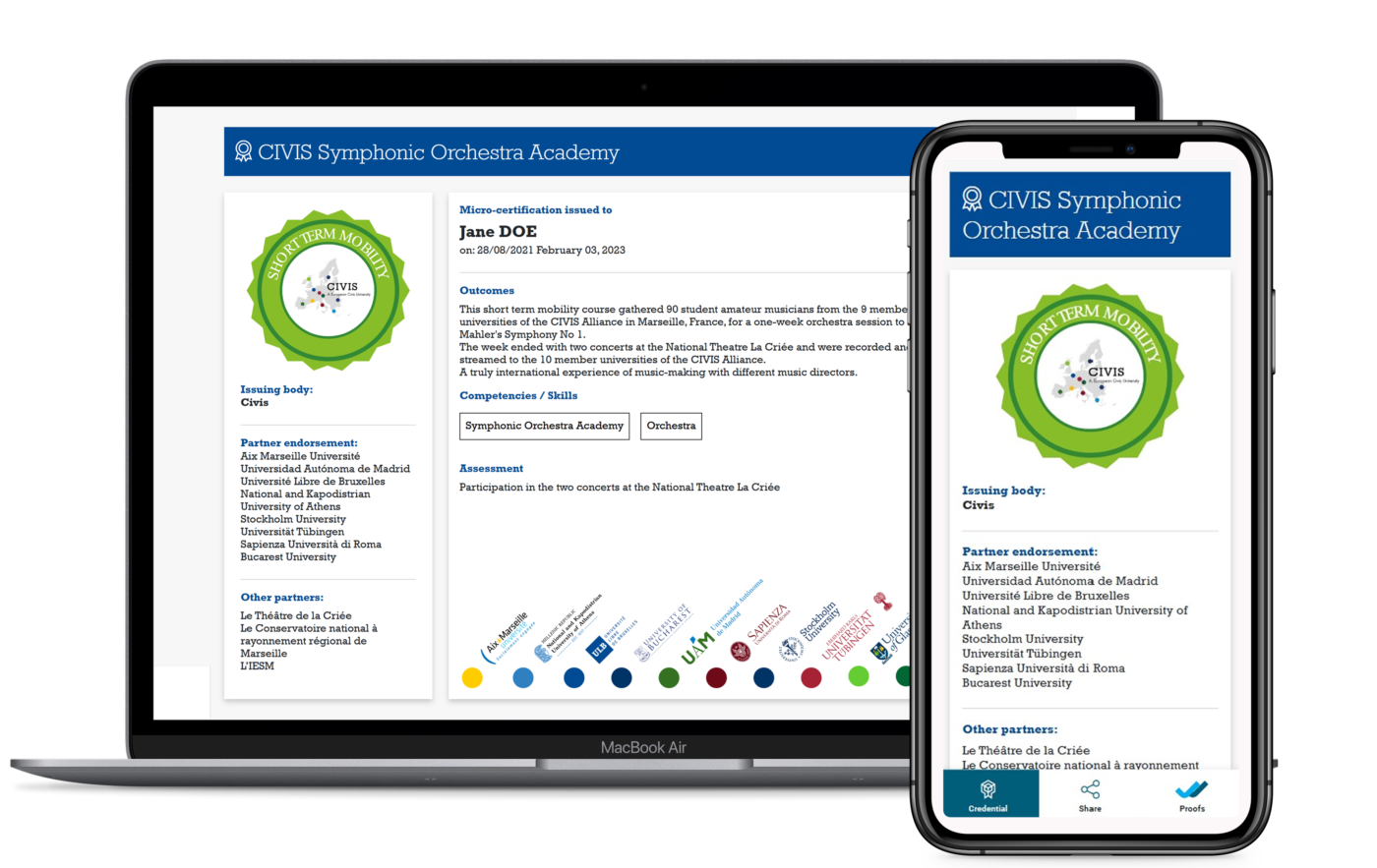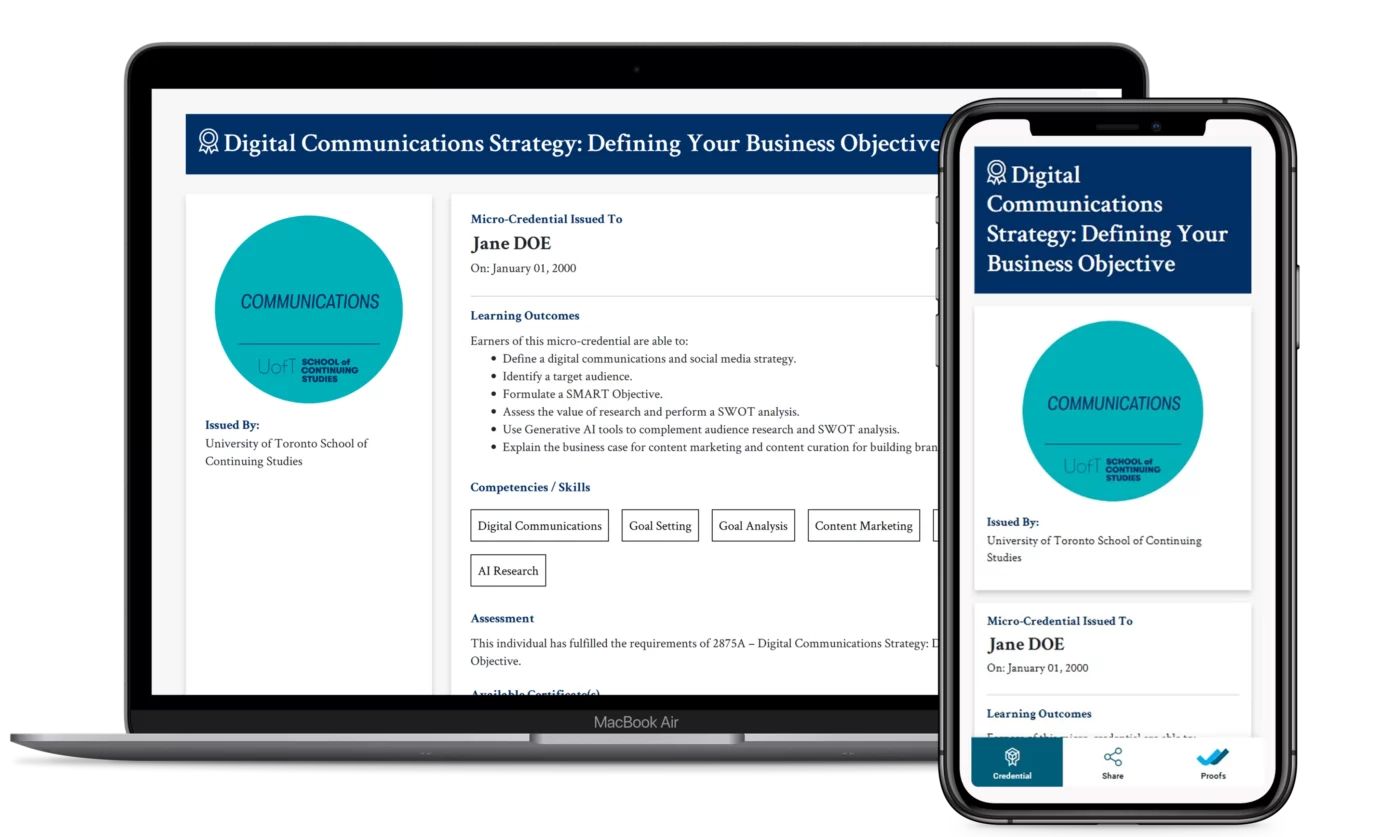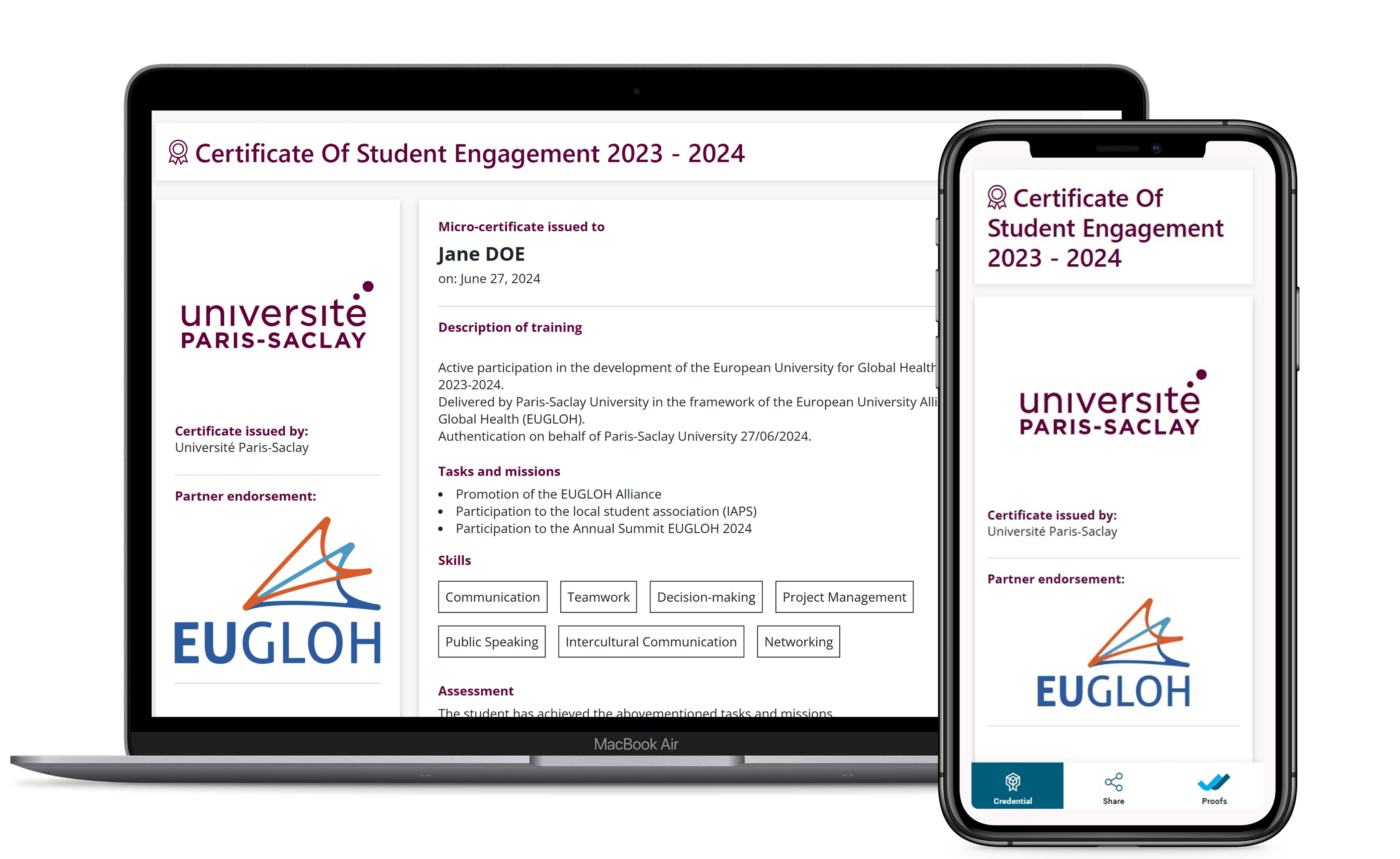Digital badges are powerful tools for recognizing learning, motivating progress, and showcasing verified knowledge and skills. They represent a modern form of credential, an open alternative, free from the physical constraints of traditional certificates.
But what do they actually look like in practice? Who uses them, and how? In this article, we will share real-world digital badge examples, their various use cases, and tips and digital badge best practices for organizations to create an effective digital badging program to support learners and earners.
📌 Need a full introduction? Start with our complete guide to digital badges.
What Are Digital Badges? (A Quick Recap)
Digital badges are verifiable, shareable online credentials embedded with rich badge metadata. This data will include the knowledge and skills recognized, the issuer, the criteria for earning it, links to evidence of completion and work done, and more.
Unlike static certificates, these badges are designed for the digital world. Earners are free to instantly share them on social media platforms like LinkedIn or via email. This open format allows anyone to verify the achievement with a single click.
Universities, corporations, and professional development organizations use badging programs to recognize learning achievement and engagement, and provide a flexible alternative to traditional certificates. Adherence to standards, such as Open Badges, ensures that these credentials are interoperable, allowing learners to manage and share their accomplishments on any platform.

Common Types and examples of Digital Badges
Digital badges come in many forms, serving a wide range of purposes across education, professional development, and community engagement. Understanding the different types of digital badges can help organizations and learners choose the right credential to recognize the level of achievement effectively. Below, we will explore the most common digital badge types, illustrated with real digital badge examples issued via the BCdiploma platform, to show how these badges function in practice. These examples show how a modern platform can create valuable credentials that earners can share across social media and email.
Achievement Badges
Purpose: Achievement badges are awarded when students or learners successfully complete a specific course, training program, or milestone. They validate the acquisition of knowledge or a skill, making them a valuable form of digital certificate for academic institutions and online learning platforms. The badges then serve as digital proof of competencies, and can boost employability.
Use cases:
- Completing a university course or professional training
- Passing skill-based assessments or certifications
- Demonstrating a high level of mastery of specialized tools or frameworks
BCdiploma digital badge example:

G. Raymond Chang School of Continuing Education at Toronto Metropolitan University.
This school awards a badge for completion of its “Project Management for Non-Project Managers” course
Why it matters: This micro-credential contains verifiable data confirming that the earner has mastered foundational project management knowledge and skills. This allows the earner to share their achievement with confidence, with verifiable badge metadata that employers can trust.
Participation Badges
Purpose: This type of digital badge acknowledge attendance or engagement in events, such as workshops, webinars, or community activities. While they may not represent a specific skill level, these badges provide evidence of enthusiasm, involvement and a commitment to professional development, particularly valuable in fast-moving fields like technology or digital HR.
Use cases:
- Attending conferences, free webinars, or seminars
- Joining hackathons or community-driven initiatives
- Participating in awareness or training campaigns
BCdiploma digital badge examples:
Honoris United Universities – Attendee Badge:
This digital badge was awarded to participants of the first-ever virtual Honoris Africa Campus, celebrating five years of the pan-African higher education network. The event marked a technological leap forward by taking place entirely in the metaverse, connecting colleagues across the African continent.

Why it matters: This badge captured the innovative format of the event and its openness to new educational paradigms. Delivered via the BCdiploma platform, the badge is verifiable, tamper-proof, and a strong example of how digital credentials can enhance experiential learning.
CIVIS – Symphonic Orchestra Academy: The academy issued a micro-certificate to students from nine European universities participating in a one-week intensive music session in Marseille, France. The project culminated in two live concerts at the National Theatre La Criée — a truly international music experience.

Notable feature: The badge features branding from all the students’ universities, including Aix-Marseille Université, Sapienza Università di Roma, and Universität Tübingen, showcasing collective recognition and institutional endorsement.
Why it matters: Participation badges help create a culture of continuous learning and show motivation that goes beyond a level of formal education. They encourage networking and ongoing engagement within professional communities.
Skill or Competency Badges
Purpose: Skill badges focus on specific, discrete competencies or abilities, rather than broader achievements. Earners will receive this type of digital badge for demonstrating a certain level of proficiency in a particular area, often aligned with industry standards or competency frameworks.
Use cases:
- Validating technical skills such as software proficiency or language fluency
- Recognizing soft skills such as communication or teamwork
- Mapping skills to professional frameworks or career pathways
BCdiploma digital badge example:

University of Toronto School of Continuing Studies – Digital Communications Strategy: Defining Your Business Objective:
This skill-based badge recognizes completion of its course Digital Communications Strategy: Defining Your Business Objective, certifying that the learner has acquired key digital strategy skills, from goal setting through to AI-supported research.
What makes this digital badge stand out
Beyond validating practical digital strategy skills, this digital badge includes embedded links to relevant online continuing education programs, such as the Digital Strategy & Communications Management program, and Strategic Public Relations certificate. This turns the badge into a professional road-map, showing what the earner has achieved and what they can learn next—a key element of effective digital badge design and a key feature a modern badging platform should provide.
Why it’s a strong example of a skill badge
This badge illustrates how digital credentials can go beyond recognition to become navigation tools for a lifelong learning journey. By linking directly to program pages, it not only showcases what the learner has achieved, but also opens up visibility into what’s next — a best practice in digital badge design that supports transparency, progression, and learner agency.
Community or Leadership Badges
Purpose: Community and membership badges identify individuals as members of a specific group or organization, recognizing involvement, leadership, or mentorship. They help foster belonging and incentivize contributions within the community.
Use cases:
- Membership in professional associations or special interest groups
- Volunteer or leadership roles within communities
- Recognition of sustained contribution or mentorship
BCdiploma Example:

Université Paris-Saclay – Certificate of Student Engagement 2023–2024
This community-focused badge issued by Université Paris-Saclay recognizes the active participation of students in the European University Alliance for Global Health (EUGLOH) during the 2023–2024 academic year. Rather than certifying a course or technical skill, this credential celebrates meaningful involvement in international collaboration and civic engagement within a pan-European academic context.
More than a recognition — a signal of civic contribution
Backed by BCdiploma’s blockchain-based credentials, this badge embeds verifiable badge metadata and clearly outlines the tasks performed, skills gained, and institutional context. It also reflects a growing trend among universities: recognizing student engagement as a core component of holistic learning.
These digital badge examples illustrate the wide range of purposes and formats these credentials can take, from validating specific skills to recognizing participation or leadership within communities.
Whether used by educational institutions, professional organizations, or companies, digital badges provide flexible, verifiable, and shareable credentials that motivate learners and enhance professional profiles.
By exploring diverse digital badge examples, organizations can better understand how to design and implement badges that meet their unique goals and effectively recognize achievements. This rich variety of digital badges demonstrates the growing importance of micro-credentials in today’s learning and professional development ecosystems.
Designing Effective Digital Badges
Well-executed digital badge design is crucial. Badges are more than just images, they are trusted records of achievement and belonging. To maximize their impact and credibility, a badging platform must carefully consider various design elements and digital badge best practices.
Visual Best Practices (Branding, Clarity)
The visual design of a badge should reflect the institution’s identity with consistent branding, including logos, colors, and typography. A clean layout ensures the badge is immediately recognizable, even as a small icon on social media or in an email signature.
Example: The CIVIS Symphonic Orchestra Academy badge stands out thanks to the co-branded layout representing nine European universities — a visual cue of international collaboration and academic prestige.
Metadata Essentials (Skills, Criteria, Expiration)
The true power of a badge lies in its badge metadata. Following the Open Badges standard, this data should include a description of knowledge and skills acquired, assessment criteria for completion, issuer details, issue date, and expiration (if relevant). This information provides context and allows for easy, free verification by employers and other stakeholders.
Badges that do this well, such as the “Digital Communications Strategy” badge from the University of Toronto, allow employers and institutions to verify not just that a program was completed, but what that means in practice.
Interactive Features That Add Value
Modern digital badges go beyond recognition and will offer next steps and interactive elements that provide more value. For example, BCdiploma-powered badges often feature:
- Clickable breakdowns of competencies the earner has demonstrated
- Access to public proof of authenticity via blockchain
This transforms the badge from a static credential into a bridge between skills and opportunities — and it’s one of the reasons why modern badge design is increasingly tied to long-term learning pathways.
Create Digital Badges with BCdiploma
Creating effective digital badges means combining strong design, rich metadata, and seamless issuance. BCdiploma makes this easy with a user-friendly platform that supports both ready-made and custom badge creation.
Each badge includes verifiable badge metadata — issuer details, skill frameworks, and proof of achievement — secured via blockchain. Badges can be issued at scale through Excel uploads or LMS integrations, with recipients receiving unique, shareable URLs.
BCdiploma also enables the design of stackable micro-credentials and digital learning pathways, helping organizations build structured, motivating certification systems.
👉 Explore our full guide to creating digital badges with BCdiploma for practical tips and digital badge best practices.
[title[Explore Real Digital Badge Examples & How They Work]] [description[Discover various digital badge examples, their types, uses, and best practices to recognize skills, participation, and achievements in education and professional fields.]]